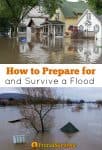[ad_1]
The recent hurricanes Harvey and Irma are making people aware of the importance of flood preparedness. While Harvey and Irma were exceptional cases, they aren’t isolated incidences.
Flooding is a common cause of disaster worldwide. With the rates of flooding disasters only increasing, it is vital to take steps toward flood preparedness to ensure survival.
The key points we’ll discuss here for flood preparedness are:
- How to Prepare for a Flood: How to stay informed, protect your home, pack a flood emergency kit, and make an evacuation plan.
- What to Do During a Flood: Risk of floodwater, evacuation during a flood, and safety of drinking water.
- Staying Safe After a Flood: Utility safety, contacting loved ones, cleaning up, and looting.
- Flood Emergency Kit: A checklist of items to stockpile for flood preparedness.
Flood Disasters Overview
Flooding is the leading cause of weather-related deaths in the USA. Approximately 200 people die annually due to flooding, and billions in damages are caused. (source)
It is an even bigger problem worldwide, with 2.3 billion people affected by flooding in the past 20 years. (source)
Despite how common flooding is, few people are prepared for a flood.
This is all despite the fact that most Americans live in an area where a natural disaster has struck.
Floods Can Happen Anywhere
Most people incorrectly believe flooding can only happen in coastal areas or near rivers.
This is not the case. As the FEMA video explains, flooding can happen anywhere. Of course, the risk is much greater if you live in a floodplain. Check the FEMA flood map to see if you live on a floodplain.
How to Prepare for a Flood
1. Stay Informed
The most important thing you can do to ensure you survive a flood is stay informed. By getting advanced warning about flooding, you can evacuate sooner and avoid much of the damage.
Get an emergency radio with NOAA alerts. You can program the radio to sound an alarm if a disaster is near you. The emergency radio will also be your lifeline to the outside world if you have to hunker down through a disaster.
There are three types of flood alerts:
- Flood Advisory: Be Aware! This is the lowest level of alert. It is issued when flooding might happen but isn’t likely to cause a warning.
- Flood Watch: Be Prepared! A flood watch is issued when conditions are favorable for flooding.
- Flood Warning: Take Action! A flood warning is only issued once a flood is imminent or in process.
Protecting Home from Flooding
Don’t wait until a flood alert has been issued to protect your home. You should have flood supplies already purchased and ready. Don’t be one of those people who rush off to the hardware store the night before a hurricane hits!
There are several steps you can take to secure your home against floodwater.
1. Keep Water Out of Home

You can use barricades and devices to keep floodwater out of your home. The main ones are:
1. Sandbags are the easiest and most affordable way to keep the water out.
They are only really suitable for mild flooding and will likely be in short supply in flooding emergencies; therefore, it is wise to stock up in advance.
2. Dams are becoming more popular with people living in flood areas. Some dams are placed in front of doors or windows to prevent water from leaking in. Others can be inflated and put around the entire property.
3. Sump Pumps are used to remove water from your house if it is already flooding. There are many different types available. You should be looking at battery-powered and\or submersible models for emergency use.
2. Turn Off Utilities
When a disaster strikes, you should immediately turn off the utilities, including gas, electric, and water. This reduces the risk of an electrical fire, burst pipes, and gas leaks.
After turning off the electric main, unplug all appliances. This helps protect them from shorting when the electricity is turned back on.
Warning:
Never turn off the electricity while standing in water. If there is already water where the electricity main is, use a long broom handle while standing on a dry surface to shut off the main.
3. Get Flood Insurance
The damage can be huge even if your home is only hit with a few inches of flooding. This is because mold can set in quickly, and cleanup is very intensive.
According to data from the National Flood Insurance Program, the cost of water damage cleanup is:
- 1-4 inches of water: $7,800
- 9-12 inches of water: $18,930
- 18 inches: $26,285
When you see these high costs, you realize why buying flood insurance is a worthwhile investment in your home security.
4. Protect Belongings from Flood Water
If you have time before evacuating from a flood, take steps to keep your property safe.
- Bring outdoor furniture inside
- Move appliances and valuable items to higher ground
- Roll up rugs and move them to higher ground
Emergency Flood Kit
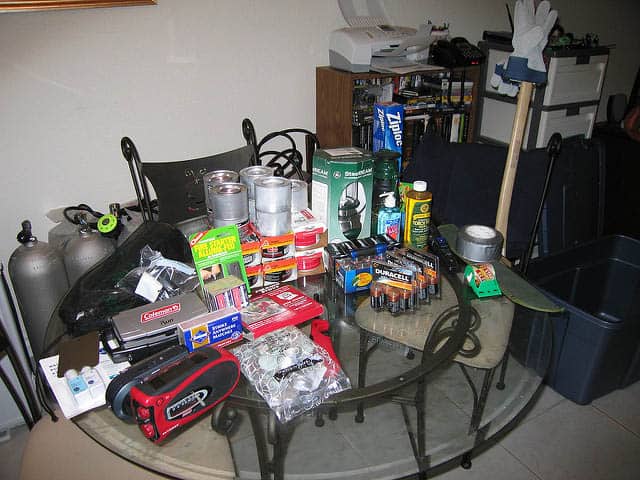
At the end of this guide, we have a comprehensive flood emergency supplies checklist. Here, I want to discuss some of those supplies and why you need them for flood preparedness.
Food and Water
While stockpiling non-perishable foods is essential, water is what you need to worry about. Tap water is unsafe to drink during flooding.
You will need to treat it first with a water purification method such as boiling or water purification tablets.
Heat/Warmth
Remember those photos of drenched flood victims stranded on their roofs? They are most certainly freezing!
Staying warm during the flood means staying dry. Be sure to have a change of clothes, waterproof boots and jackets, and emergency wool blankets (which dry faster than cotton).
First Aid
With all the debris that flooding causes, it is easy to get abrasions. Make sure there is antibacterial ointment in your first aid kit to treat any wound that comes into contact with floodwater. The last thing you need is an infection developing.
Incidences of diarrhea and vomiting are also common during flood emergencies because of contact with tainted water. For this, it is vital to have electrolytes (Amazon Link) on hand to treat dehydration and anti-diarrheal medications. (Amazon Link)
Light
Even if the electric grid works during a flood, you should keep all electricity off. This reduces the risk of fire.
It can be very stressful to sit through a flood in the dark. Aside from comfort, you’ll need light to find your way in the dark during an emergency evacuation.
I find that headlamps are the best emergency light option. They are worn on the head, so your hands are freed up for other tasks. Never use candles during a flood because of the risk of gas leaks.
Emergency Toilet
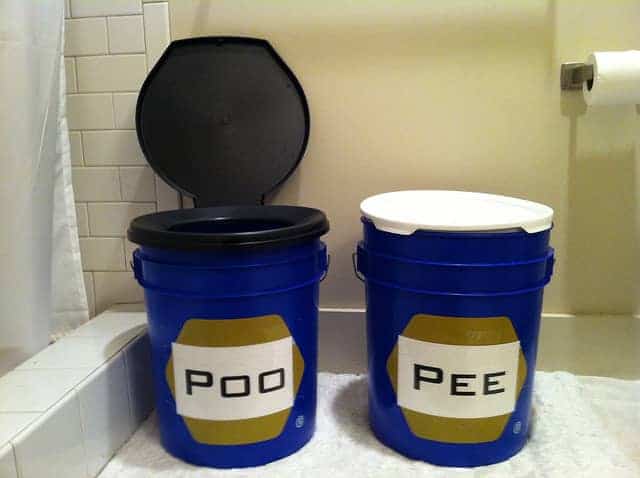
It amazes me how many people forget to prepare an emergency toilet. I know the idea of crapping into a bucket isn’t attractive, but not having any emergency toilet would be even worse!
Remember, you probably won’t be able to use your home’s toilet during flooding. The excess water in the sewage system means backups can occur if you try to flush. You should put sandbags over your toilets to prevent sewage backflow!
Making an emergency toilet is simple. The “cleanest” method is the two-bucket emergency toilet.
Flood Evacuation Plan
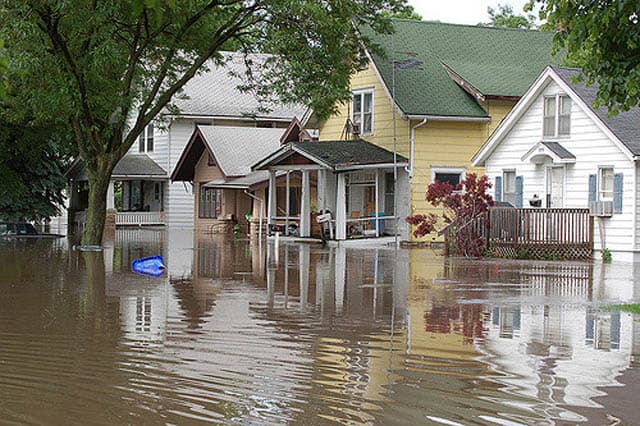
If a flood forces you to leave your home, you want to ensure you can get out safely. This means having a plan in place.
These are the 4 aspects to consider when making your flood evacuation plan.
1. Under What Circumstances Will You Evacuate?
The sooner you leave, the better your chances are of escaping the flood. However, many people are reluctant to leave their homes. Wishful thinking leads them to believe, “This could never happen to me” or “It won’t be that bad.”
It is difficult to reason during a disaster. So, make a plan before a flood watch or warning takes place. Learning about the categories of storms will help you make this decision.
2. Where Will You Go?
Hopefully, you have friends or relatives that live outside the flood zone. Ask them if you could come to them in a disaster.
You could head to a hotel until the flood passes. You’ll need to set aside money to pay for the accommodation bill. However, hotels often are fully booked during flood disasters. In these situations, churches, community groups, and even locals might open their doors to flood victims.
But what if flooding makes it impossible to leave the area? You might need to evacuate to a storm shelter. On the Red Cross website, you can search for a storm shelter.
Be sure to have the contact info of the storm shelter handy. Grid outages mean you might not be able to search the web once flooding is in effect!
For more on this, read How to Make a Disaster Evacuation Plan.
3. How Will You Get There?
You’ll need to use your emergency radio to check road conditions to see whether it is safe to evacuate by vehicle. If you don’t have a vehicle, the emergency radio can be used to learn about evacuation buses.
Consider getting an inflatable raft (Amazon Link) in case of flooding. You can take the boat to the nearest shelter if you cannot drive.
4. What To Do If Stuck in Home During Flooding
One of the biggest hurricane mistakes people make is going to their attic. Not realizing how quickly flood water can rise, they end up trapped inside and drown.
Don’t go to your attic if you ever find yourself in a flood disaster. You’d be better off on the roof where you can signal for help.
Consider getting an emergency rooftop hatch for your attic. This way, you can safely go up to your attic during a flood. If the water rises to this level, you can safely escape the attic through the rooftop hatch.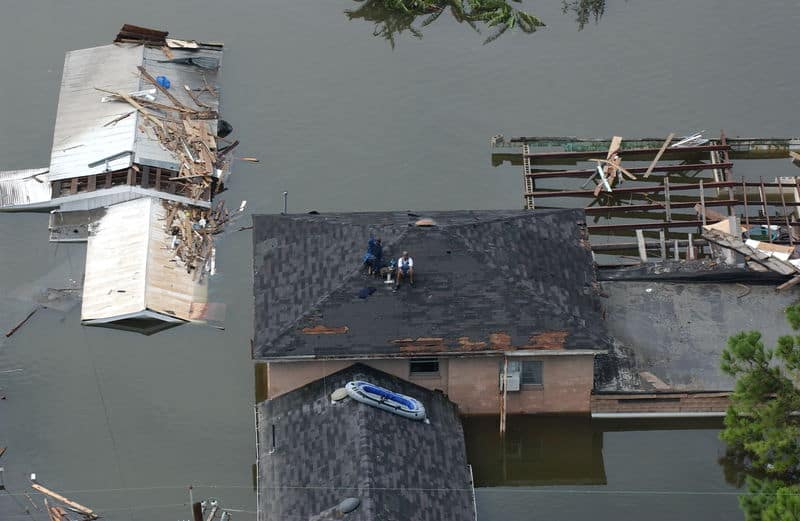
What to Do During a Flood
Risks of Flood Water
Many of the deaths and injuries that occur during flooding are because people underestimate the power of floodwater.
Even small amounts of floodwater are enough to wash you away and drown you.
- 6 inches of water: Will knock you off your feet. It will also reach the bottom of most cars and cause them to lose control.
- 12 inches of water: Will float many vehicles.
- 24 inches of water: Will carry away even large vehicles like SUVs.
Other Risks of Flood Water Include:
- Electrified Water: Downed power lines or lights can electrify water. Stepping into it can cause death by electrocution.
- Disease: Flood water contains toxic wastes, including sewage. Coming into contact with it or accidentally drinking flood water can result in health complications.
- Injury: Debris floating in flood water can cause serious injuries.
- Damaged Buildings, Roads, and Bridges: Flood water can wash away building materials. Be careful before entering flooded buildings as the floor could collapse. Bridges and sidewalks could collapse under you.
Evacuating During a Flood
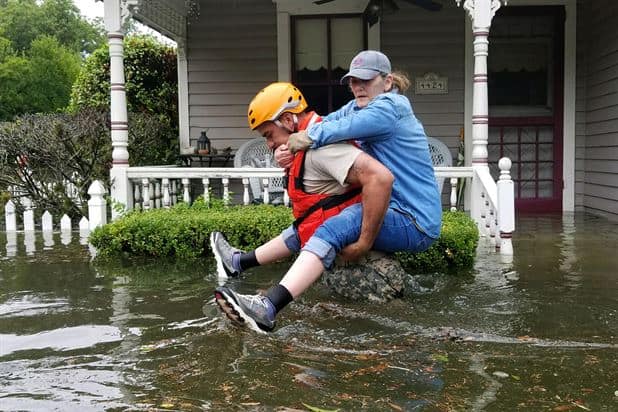
In most cases, it is best to hunker down in your home until the storm passes and the floodwater goes down. It can take days or weeks for flood water to recede, so it is important to have emergency supplies stockpiled.
Even if you are prepared to stay in your flooded home, it isn’t always wise. Stagnant floodwater can quickly turn toxic. Mold growth can start in as little as 24 hours – creating respiratory issues if inhaled. Thus, once the threat has passed, many people choose to leave their flooded homes.
An evacuation order might also be placed if your home is flooded. Rescue workers will go door-to-door evacuating people to shelters. You’ll be forced to evacuate, whether you want to or not.
To make sure you can evacuate quickly and safely:
- Pack Bug Out Bags ahead of time.
- Consider buying a boat or raft to use for flood evacuation.
- Keep whistles, flares, and neon paint (Amazon Links) to be used for signaling to rescue workers.
- Go to the roof, never to the attic or anywhere you could get trapped by floodwater.
- Don’t fight an evacuation order. Listen to the authorities.
Drinking Water Safety
Use your emergency radio to listen for drinking water alerts during the flood. Unless the water company explicitly says tap water is safe, assume it is contaminated and do not drink it.
Often, water companies will issue a “boil alert” during flooding. This means that you should boil tap water for at least 1 minute before drinking or cooking with it. Even water for brushing your teeth should be treated.
Boiling doesn’t remove chemical contaminants, though. This usually isn’t an issue for healthy adults. However, infants can be susceptible to nitrates in water. Only bottled water should be used for mixing infant formula.
To learn more about water preparedness, read these articles:
Stay Safe After a Flood
Utility and Electrical Safety
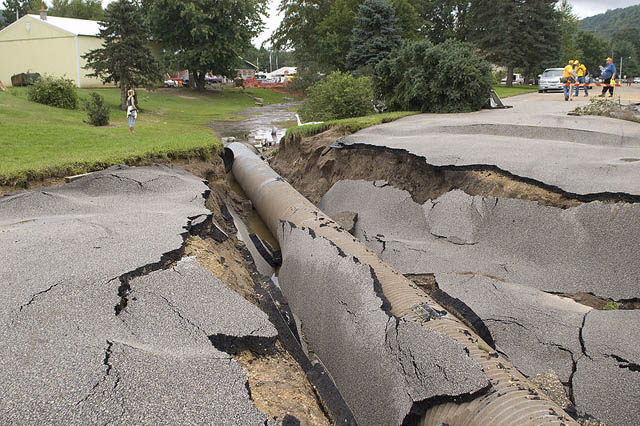
No matter how eager you are to get your power and water back, never turn on the utilities until you have checked with the authorities.
The risk of electrical shock or fire is great after a flood. If you couldn’t shut off your electric main before leaving your home, do not reenter until an electrician has checked for safety. Likewise, don’t re-plug any electrical appliances that got wet until an electrician inspects them.
Contacting Loved Ones
Landline phones typically don’t work after large disasters. Even cell phones often don’t work because networks get flooded.
However, internet connections often do work. You can contact loved ones using email or social media. You’ll need a way to recharge your phone to stay connected, such as a solar or hand-crank charger.
If you get separated from loved ones during flooding:
- Have a designated contact person to reach in case family members are separated.
- Decide on a meeting point in case of separation.
- Check your loved one’s social media pages. People often check in there.
- Use the Red Cross Safe and Well website to register yourself as safe or to search for loved ones.
These issues should be considered before disaster strikes. Learn how to make an emergency communication plan.
Cleaning Up Flood Damage
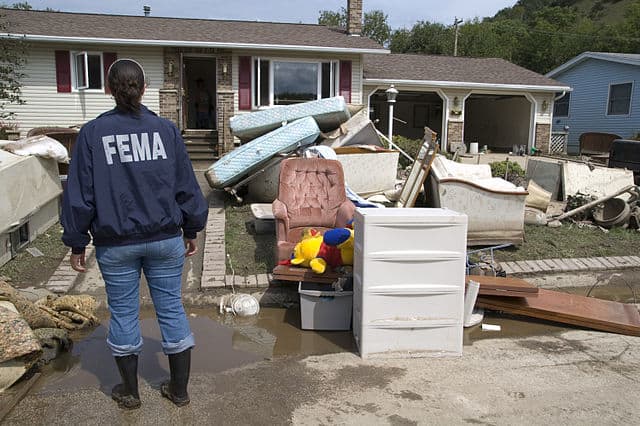
Wait until authorities say it is safe to return home. If you find your home is still surrounded by water, do not enter.
Remember that flooding can cause severe damage to your home. There could be extensive structural damage, meaning you could fall straight through floors or have the roof collapse on you. It is better to be safe than sorry in this situation!
If you do deem it safe to start the flood cleanup process:
- Take photos: You’ll need these for a flood insurance claim.
- Wear protective gear: You’ll need waterproof boots, trousers, rubber gloves, and an N95 face mask. This protects against toxic water and debris.
- Disinfect all surfaces: Flood water can contain toxins and sewage. Anything that has come in contact with flood water must be disinfected or thrown away.
To learn more, Flood Safety has a good guide to cleaning up after a flood.
Looting
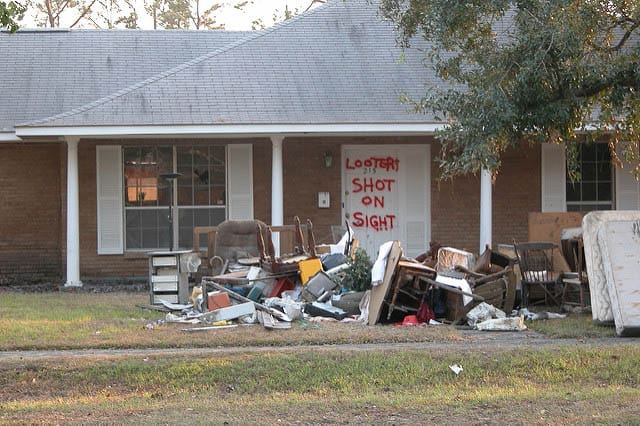
Unfortunately, looting is common after disasters. Boarding up broken windows can help prevent looting, as thieves will usually go for the easiest target. You might also want to join your neighbors to form a watch.
Others take a more aggressive approach to preventing looters – such as writing warning signs on their doors that “Looters will be shot.”
Emergency Kit Checklist
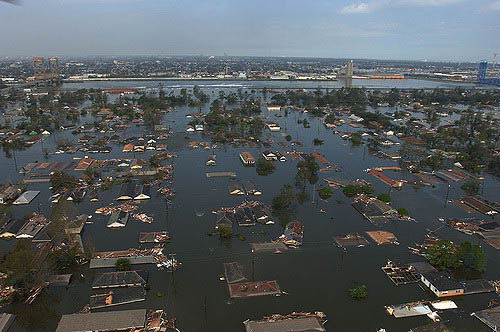
You’ll need to divide your flood disaster supplies into two categories: Supplies for evacuating and supplies for remaining in your home.
Supplies for Evacuating before/during a Flood (With Amazon Links)
- Bug out Bag: Your bug out bag will contain food, water, first aid items, clothing, and other essential gear. Get a 3-Day Bug Out Bag Checklist.
- Emergency documents: These should be waterproofed and put in your bug out bag. Here’s a List of Emergency Documents to Prepare.
- Dry sacks: These keep gear dry and can also store wet gear. A sizeable dry sack can also serve as your bug out backpack.
- Boat/raft with fuel or oars: Not everyone can keep a boat in their home. However, if you live in a flood area, you should at least have an inflatable lifeboat.
- Dry suit: Floodwater contains sewage and other toxic waste. If you have to go out in it, always wear protection. Sanitize gear that has come in contact with floodwater.
- Distress signals: These include signal flares. and signal mirrors.
- Glow sticks: These improve visibility during stormy and dark conditions.
- Pet carriers and supplies: Read this post about Disaster Preparedness for Pets.
- Life jackets: Even if you don’t have a boat, you’ll want life jackets. It only takes a few inches of floodwater to sweep someone off their feet!
- Sandbags or polyethylene pipe barriers: When flooding is imminent, you should plug drains to prevent sewage backup. Remember to do this before you evacuate to minimize damage to your home. Drains should also be blocked if you are staying at home. Use an emergency toilet during the flood instead of relying on the sewage system.
- Shutoff Wrench: Turn off gas, water mains, and electricity before evacuating. Always turn off utilities when hunkering down too.
- Extra cash
- Map and compass
- Emergency numbers and addresses
Flood Supplies for Remaining in Your Home(With Amazon Links)
- Bottled water: The minimum amount you should have is 1 gallon per day, per person. However, it is best to have more.
- Non-perishable food: MREs and “boil in the bag” foods are good choices for flood preparedness. Aim for a variety of these Emergency Preparedness Foods
- Water treatment method: Flood water contains bacteria, viruses, and chemicals. Boiling alone won’t be enough to treat it. Read this Guide to Water Treatment Methods.
- How to Choose an Emergency Radio.
- Flashlights: Because of heavy winds and potential gas leaks, it is best to avoid candles during most natural disasters. Instead, use flashlights. Look for ones with a high IPX (waterproof) rating.
- Supplies for boarding up windows: These include wood, hammers, nails, plastic tarp, and duct tape. Here’s a video of how to board up windows.
- Tools: These include pliers.
- Gas stove: This is for cooking and boiling water for sanitizing.
- Power source: Cellphones (though not always reliable) have become crucial for communication during a flood. Have a backup way to keep your phone and other devices powered, such as a solar panel, USB power bank, and rechargeable batteries and charger.
- Fire extinguisher: Opt for the ABC rating.
- Emergency toilet: The two-bucket method is the easiest way to do this.
- Trash bags: You’ll need a LOT of these for your emergency toilet and other waste, especially if you need to bag up items contaminated by the floodwater.
- First aid skills too!
- Mess kit: Camping-style kits are great for emergency prepping.
- Waterproof matches
- Tent – How to choose the best survival tent
- Sleeping bags
- Face masks
Where to Store Flood Emergency Supplies
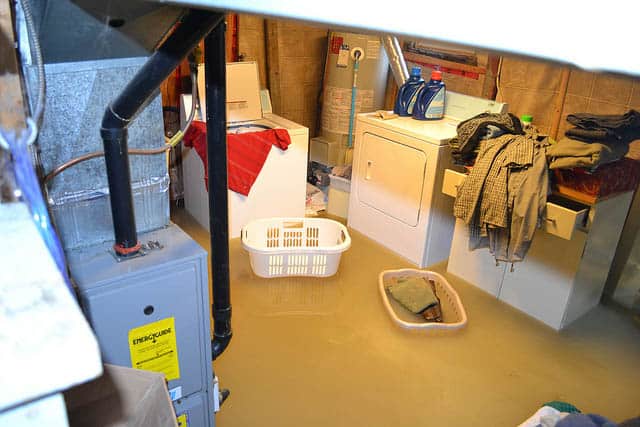
The safest room during a hurricane is an interior room without windows on the first floor. Ideally, you will have your flood emergency supplies in this room.
However, since the “safe room” is often a bathroom or pantry, you might not be able to get all of the supplies in the safe room. In this case, consider where you can keep the supplies nearby, so they are accessible.
You’ll never want to keep flood supplies in the basement, garage, or other areas which will get flooded first or be inaccessible during flooding.
If you have a roof escape hatch installed, consider keeping some emergency supplies here too. Floodwaters rise rapidly, and you might not have time to carry supplies to the attic while escaping the water.
[ad_2]
Source link
